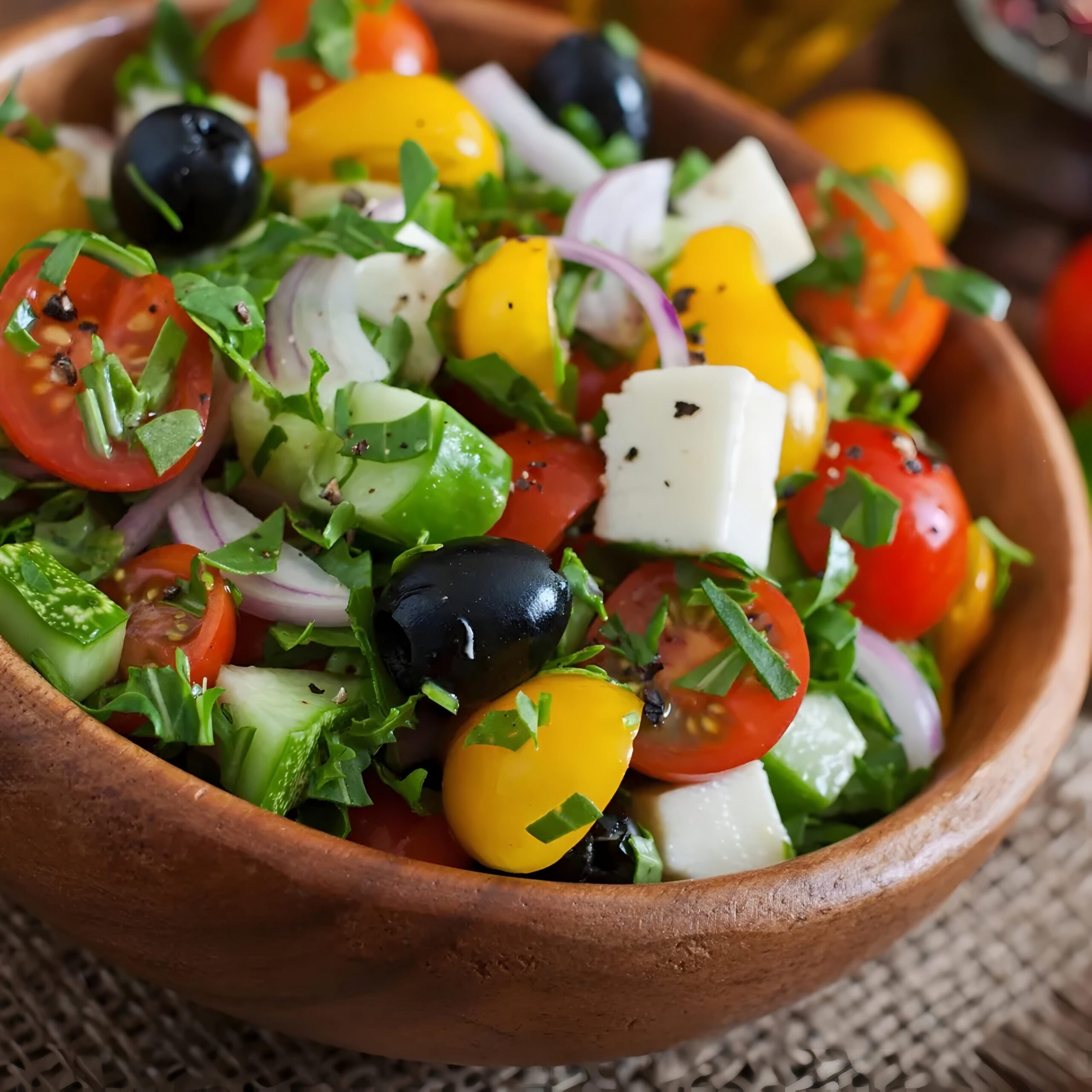Introduction:
Greek salad, also known as “Horiatiki,” is a refreshing and vibrant dish that originates from Greece. It is a perfect combination of fresh vegetables, olives, feta cheese, and a simple dressing. This salad is not only delicious but also packed with nutrients. Let’s dive into the step-by-step process of making a mouthwatering Greek salad.
Greek Salad Ingredients:
- At the heart of a Greek salad lies a carefully curated selection of fresh, high-quality ingredients. Each component plays a vital role in creating the unique flavors and textures that make this dish so beloved.
- Ripe Tomatoes: The star of the show, juicy and vibrant tomatoes are the foundation of any good Greek salad. Look for tomatoes that are deeply red, firm, and bursting with flavor.
- Cucumber: Providing a refreshing crunch, cucumbers are a staple in this salad. Choose crisp, seedless cucumbers for the best texture.
- Red Onion: The pungent aroma of red onion adds depth and complexity to the salad. Soaking the sliced onions in cold water helps mellow their sharpness.
- Bell Peppers: A medley of colors, bell peppers contribute a sweet, crisp note to the salad. Green and red peppers are most commonly used, but feel free to experiment with other varieties.
- Kalamata Olives: No Greek salad would be complete without the rich, briny flavor of Kalamata olives. These deep purple gems add a burst of saltiness and a distinctive taste that complements the other ingredients perfectly.
- Feta Cheese: Crumbled feta cheese is the crowning glory of a Greek salad. Made from sheep’s or goat’s milk, this creamy, tangy cheese adds a delightful contrast to the fresh vegetables.
- Fresh Oregano: A sprinkle of fresh oregano leaves imparts an earthy, herbaceous aroma that ties all the flavors together.
- Salt and Pepper: Simple yet essential, salt and pepper are the final seasoning touches that enhance the natural flavors of the ingredients.
For the Dressing:
- While the ingredients in a Greek salad are undoubtedly the stars, the dressing is the unsung hero that brings everything together in perfect harmony. A classic Greek salad dressing is a simple concoction of:
- Extra Virgin Olive Oil: The foundation of any good Greek dressing, high-quality extra virgin olive oil lends its rich, fruity flavor and velvety texture.
- Red Wine Vinegar: Providing a bright, tangy note, red wine vinegar cuts through the richness of the olive oil and adds a delightful acidity to the dressing.
- Garlic: A clove of fresh garlic adds depth and an unmistakable aroma that complements the other flavors beautifully.
- Dried Oregano: Echoing the fresh oregano in the salad, dried oregano contributes an earthy, slightly bitter taste that rounds out the dressing’s flavor profile.
- Dijon Mustard: A touch of Dijon mustard acts as an emulsifier, helping to bind the dressing and adding a subtle tang.
- Salt and Pepper: As with the salad itself, a pinch of salt and a grind of fresh black pepper enhance the flavors and bring the dressing to life.
Greek Salad Preparation:
- The beauty of a Greek salad lies not only in its flavors but also in its simplicity of preparation. With just a few easy steps, you can create a dish that will transport you to the sun-drenched shores of the Mediterranean.
- Begin by washing and chopping the tomatoes into bite-sized chunks, placing them in a large salad bowl. This allows the natural juices to mingle with the other ingredients, creating a delightful dressing of its own.
- Next, prepare the cucumber by peeling and cutting it into half-moons. Add these refreshing slices to the bowl, their crisp texture providing a delightful contrast to the juicy tomatoes.
- Thinly slice the red onion and separate the rings, then soak them in a bowl of cold water for about 10 minutes. This simple step helps to tame the onion’s pungent aroma, ensuring a well-balanced flavor in the final dish.
- Core and seed the bell peppers, cutting them into thin strips. The vibrant hues of green and red peppers not only add a burst of color but also contribute a delightful crunch to the salad.
- Scatter the Kalamata olives throughout the salad, making sure to pit them if necessary. These briny gems add a depth of flavor and a distinctive taste that is quintessentially Greek.
- Now, it’s time to introduce the star of the show – the feta cheese. Crumble the creamy, tangy feta over the vegetables, adjusting the amount to your personal preference. This cheese adds a rich, salty note that perfectly complements the fresh produce.
- If you’re a fan of fresh herbs, sprinkle some oregano leaves over the salad. The earthy aroma of this Mediterranean herb will elevate the flavors and transport you to the sun-drenched islands of Greece.
- Season the salad with a generous pinch of salt and pepper, keeping in mind that the feta cheese and olives already contribute a certain level of saltiness.
- In a separate bowl, whisk together the ingredients for the dressing: extra virgin olive oil, red wine vinegar, minced garlic, dried oregano, Dijon mustard, salt, and pepper. This simple yet flavorful dressing is the final touch that brings all the elements together.
- Pour the dressing over the salad and gently toss all the ingredients until they are evenly coated. Be gentle, as you don’t want to bruise the delicate vegetables or break down the feta cheese too much.
- Now, here’s a tip from the Greek grandmothers: let the salad sit for a few minutes before serving. This resting period allows the flavors to meld and mingle, creating a harmonious marriage of tastes and textures.
Conclusion:
As you take your first bite of this vibrant and flavorful Greek salad, you’ll be transported to the sun-drenched shores of the Mediterranean. The combination of fresh, crisp vegetables, tangy feta cheese, and briny olives, all brought together by a simple yet delicious dressing, is a true celebration of the flavors of Greece.
This salad is not just a dish; it’s a culinary experience that embodies the essence of Greek cuisine – simplicity, freshness, and a deep respect for the natural flavors of the ingredients. Whether served as a refreshing appetizer or a light main course, a Greek salad is a perfect representation of the Mediterranean diet, known for its health benefits and delectable flavors.
So, gather your ingredients, roll up your sleeves, and embark on a journey to the sun-kissed shores of Greece. With each bite, you’ll be transported to a world of vibrant colors, tantalizing aromas, and flavors that will leave you craving for more. Enjoy this taste of the Mediterranean, and let the simplicity and freshness of a Greek salad inspire your culinary adventures.
Here are some potential FAQs for the Greek Salad recipe:
Q: Can I substitute other types of olives instead of Kalamata olives?
A: While Kalamata olives are traditional in a Greek salad, you can substitute other varieties like black olives or green olives if you prefer. However, the Kalamata olives provide a distinctive briny, rich flavor that pairs well with the other ingredients.
Q: Is it okay to use regular vinegar instead of red wine vinegar?
A: Red wine vinegar has a distinct flavor that complements the other Mediterranean ingredients well. However, you can substitute it with white wine vinegar or even lemon juice in a pinch. Regular white vinegar may be a bit too sharp.
Q: Can I make the dressing ahead of time?
A: Yes, you can make the dressing a day or two in advance. Store it in an airtight container in the refrigerator. Give it a good whisk or shake before dressing the salad to re-emulsify.
Q: Is it necessary to soak the red onion slices?
A: Soaking the red onion slices in cold water for 10 minutes helps to remove some of their sharp, pungent flavors. This step is optional, but recommended if you prefer a milder onion flavor.
Q: Can I add other ingredients to the salad?
A: Absolutely! Greek salads can be quite versatile. You can add ingredients like sliced radishes, avocado, roasted red peppers, or artichoke hearts to customize it to your liking.
Q: How long does the salad keep in the refrigerator?
A: It’s best to enjoy a Greek salad fresh, but leftovers will keep in the refrigerator for 2-3 days. Keep in mind that the vegetables may release more juices and the textures may soften over time.
Q: Can I make this salad vegan by omitting the feta cheese?
A: Yes, you can easily make this Greek salad vegan by omitting the feta cheese. The fresh vegetables, olives, and dressing will still provide plenty of flavor.
Q: Is there a way to make the salad ahead of time?
A: While it’s best to assemble the salad just before serving, you can prepare some of the components ahead of time. Chop the vegetables and make the dressing a day in advance, then combine everything right before serving.
Q: Can I use dried oregano instead of fresh?
A: Fresh oregano provides a vibrant, herbaceous flavor, but you can substitute dried oregano if fresh is not available. Use about 1 teaspoon of dried oregano for every tablespoon of fresh called for in the recipe.





